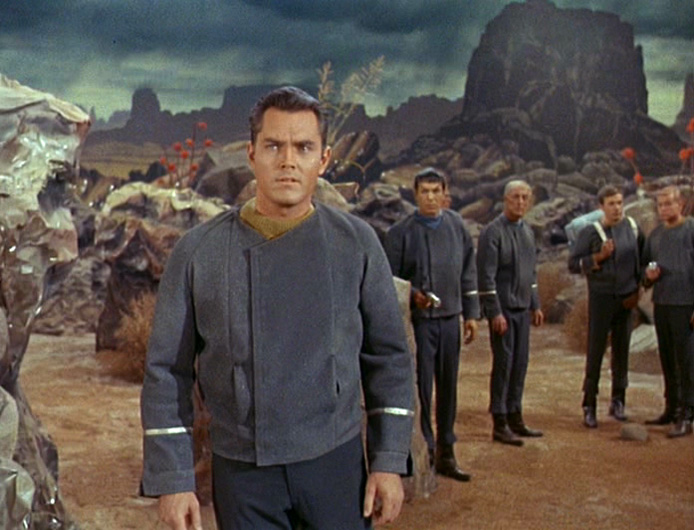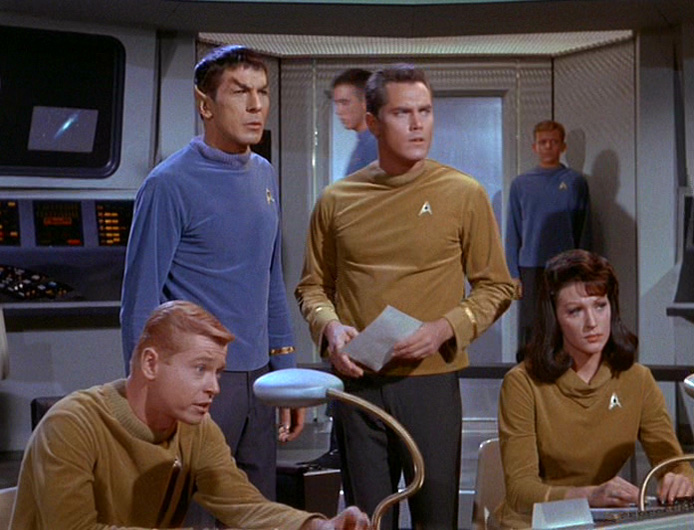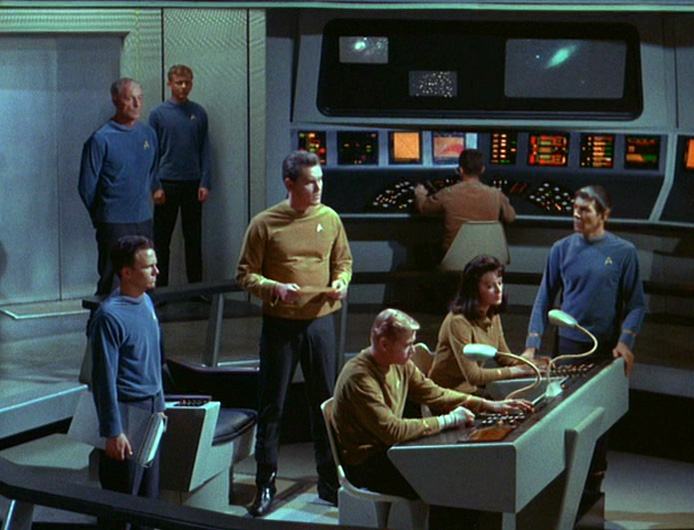
Star Trek has come a long way since The Cage, the original unaired pilot for Gene Roddenberry’s science fiction TV show that was deemed “too cerebral” by the folks at NBC. It’s easy to look back at NBC’s decision to pass on this first version and say it was the right call, given the popularity of all that has come in its place since. But to judge these 64 minutes of sci-fi on their own merits and out of the context of the rest of Star Trek lore reveals something fairly surprising: The Cage is actually pretty good. Not just good by TV or science fiction standards, but (most importantly) by Star Trek standards. By setting aside the rest of the Star Trek universe for a moment, it becomes apparent how deep the influence of this mostly forgotten episode runs throughout the entirety of the franchise.
Since its production and subsequent non-airing, The Cage has developed a very special place in Star Trek history, even if it’s not entirely clear just what that place is. You won’t find it on any Top 10 best-of lists, it’s mainly regarded as a strange footnote in the franchise’s long history. But what’s most surprising about watching The Cage and forgetting (or trying, at least) about the rest is how easily it fits in. A show based on this pilot could have actually been pretty good. This is a compelling, thoughtful piece of television with several strong characters that could have very well garnered a loyal following. Seriously, it’s a lot better than you think.

Does it have its flaws? Sure. What pilot doesn’t? Obviously the special effects are antiquated and at times borderline cheesy. Yes, it’s a bit silly that the Star Trek theme plays with exaggerated flourish whenever the Enterprise hits “Time Warp” speed. There are a few too many extras standing awkwardly on the bridge with no real purpose, and the red alert sound that plays near the beginning of the episode is utterly horrendous. The other alien captives look like something out of Tom Baker-era Doctor Who, particularly the large, orange monkey-thing. This certainly has many of the hallmarks of a 1960s sci-fi show.
Worst of all, what’s most striking about The Cage is just how WHITE this Star Trek universe is. There is no Sulu, no Uhura, there isn’t even a Chekhov or Scotty. Spock is the only real hint at diversity, and obviously that barely counts. Even the monstrous Kaylar (sound familiar?) is a white man. For all the strides Star Trek took towards changing the television landscape, there’s no real hint of that here.
But still, there’s a lot to like. For all the talk of its lack of action, The Cage hits the ground running. Fresh off a disastrous mission to Rigel VII, the Enterprise’s much-needed trip to the nearest starbase is interrupted by a mysterious distress signal. There’s a lot to process in the first few minutes, but it works. Whereas Kirk’s swagger jumps off the screen the second you see him, Captain Pike (played by Jeffrey Hunter) is much more introspective. His last mission cost him several crew members, which frames his reluctance to go off on another uncertain task before tending to his wounded crew. Kirk thrives for the captain’s chair while Pike questions his desire to remain in it. You can see, perhaps, why the network balked at this type of lead for the show, but a complex character like Pike fits quite well in today’s television landscape.

And isn’t it most fitting that the first words ever uttered in an episode of Star Trek are said by Spock? Sure, his “Check the circuit!” is by no means a declaration of arrival, but it does make sense that the character who, arguably more than any captain, has come to symbolize Star Trek is also the one who gets the ball rolling. Make no mistake, this isn’t quite the Spock you’ve come to know and love. He’s not the First Officer (yet), he’s more animated, and his eyebrows are much bushier. “The Menagerie”, the first season episode that spliced in scenes from The Cage in order to give Roddenberry’s special effects team a chance to get caught up, establishes that this Spock is over a decade younger than the one standing by Kirk’s side. While this may be a mostly-forgotten chapter in the Enterprise’s record book, it still begins on the proper note.
If James T. Kirk’s Enterprise is Wagon Train to the Stars, then Christopher Pike’s is The Twilight Zone in Space. Or perhaps The Outer Limits, since Roddenberry studied that show’s production closely and even hired several of its writers once Star Trek got underway. The Talosians and their extraordinary mental powers seem ripped right from an episode of either of those vaunted sci-fi classics. At the same time, their study of humanity via Pike and his reactions to their tests would be echoed much later by Q in “Encounter at Farpoint.” This is a show that wants you to think, which is not to imply that Pike’s Trek is smarter than Kirk’s. But with its conflicted lead character, his close friendship with the ship’s doctor (ahem), the seeds of a potential love triangle, and the mystery surrounding Majel Barrett’s Number One (AHEM), this show really could have been something.

This may be a mostly different cast (only Leonard Nimoy and Majel Barrett made the jump to the series proper) but at its heart The Cage is quintessential Star Trek. The adventure here slips very easily into the long catalogue of episodes where the resolution is more thinking than it is punching and shooting. It’s no “City on the Edge of Forever”, but it’s still a solid piece of science fiction. And there is plenty of STAR TREK here. We’ve got our first beam down to an alien planet, our first dancing green girl, our first gadgets. There’s a hand-held communicator and laser guns that are clear precursors to the classic phaser. Any way you look at it, this IS an episode of Star Trek.
The Cage did not see the light of day as a proper, intact episode for over two decades, and that’s a real shame. You can’t help but imagine that sort of neglect has helped give this rejected pilot a stigma of failure (calling it a “rejected pilot” probably doesn’t help much either). But do yourself a favour and watch it, either again or for the first time (it’s streaming on Netflix now). It’s not exactly the show you or your parents grew up with, but that doesn’t mean it isn’t still a worthwhile instalment of the franchise. It deserves respect and reverence. This is no cheap imitation, this is the real deal. This is Star Trek. It’s just, you know, a little different.




